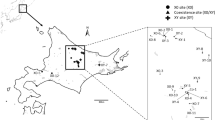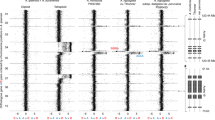Abstract
Two basic chromosome numbers, 7 and 9, have so far been reported for members of the genus Pennisetum, which belongs to the tribe Paniceae of Gramineae1. We recently recorded the somatic chromosome numbers 10 and 32 in the species Pennisetum ramosum C. Sm. and P. massaicum Staf., which suggests two additional basic numbers, 5 and 8, for this genus. Both P. ramosum and P. massaicum are natives of tropical Africa and are perennials with profusely branched culms. Both possess all the key characters of the genus Pennisetum. Thus, the spikelets are solitary and are surrounded by an involucre of bristles that are free except at the very base. The first glume is shorter than the spikelets; the second glume is almost equal to the sterile lemma in size and the fertile lemma is smooth with a thin margin enclosing the palea.
This is a preview of subscription content, access via your institution
Access options
Subscribe to this journal
Receive 51 print issues and online access
$199.00 per year
only $3.90 per issue
Buy this article
- Purchase on Springer Link
- Instant access to full article PDF
Prices may be subject to local taxes which are calculated during checkout
Similar content being viewed by others
References
Darlington, C. D., and Wylie, A. P. “Chromosome Atlas of Flowering Plants” (George Allen and Unwin, Ltd., 1955).
Hrishi, N. J., Genetica, 26, 280 (1952).
Author information
Authors and Affiliations
Rights and permissions
About this article
Cite this article
SWAMINATHAN, M., NATH, J. Two New Basic Chromosome Numbers in the Genus Pennisetum . Nature 178, 1241–1242 (1956). https://doi.org/10.1038/1781241a0
Issue Date:
DOI: https://doi.org/10.1038/1781241a0
This article is cited by
-
Biotypic differences in the karyology ofPennisetum pedicellatum Trin
Biologia Plantarum (1982)
-
Inter- and intra-genomal chromosome pairing in an interspecific hybrid and its bearing on basic chromosome number inPennisetum
Genetica (1968)
-
Cytogenetical and related studies in the genus Phleum L.
Euphytica (1967)
-
Cytology and genetics of forage grasses
The Botanical Review (1961)
Comments
By submitting a comment you agree to abide by our Terms and Community Guidelines. If you find something abusive or that does not comply with our terms or guidelines please flag it as inappropriate.



